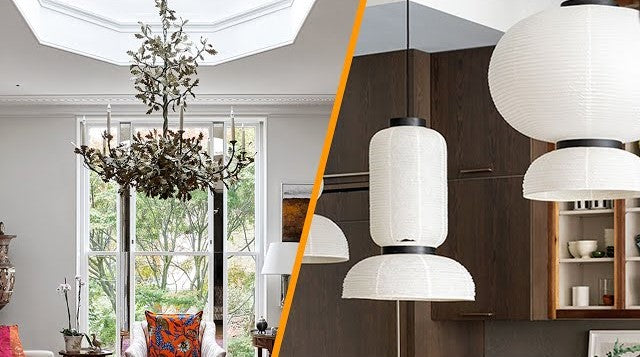
What's the Difference Between a Pendant Light and a Chandelier?
|
|
Time to read 8 min
Free shipping for $500+ orders to Sydney Metro
|
|
Time to read 8 min
When it comes to choosing the perfect lighting solution for your home, two popular options often come to mind: pendant lights and chandeliers (which can also be referred to as a 'Crystal Pendant'). While both fixtures are suspended from the ceiling and bring character to any space, they serve different purposes and come with unique features. This article will unravel the key differences between a pendant light and a chandelier, helping you decide which one suits your lighting needs best.
Table of Content
Pendant lights are versatile, stylish fixtures typically suspended from the ceiling by a cord, chain, or metal rod, serving as an efficient single light source. They usually feature a single bulb enclosed within a variety of shades, ranging from glass, metal to fabric, making them efficient light sources. Due to their streamlined design, pendant lights come in many shapes and sizes, making them adaptable to different interior design themes. This is a notable difference between a chandelier and pendant light fixtures. Whether it's a sleek, modern kitchen or a cozy, vintage living room, a well-chosen pendant light can act as a captivating focal point.
The primary function of a pendant light is to offer focused illumination, which is why they're excellent for task lighting. Imagine working at a kitchen island chopping veggies or reading a book in a cozy nook; a pendant light directs light precisely where you need it, serving as an efficient single light source. Because they hang directly above the task area, they eliminate shadows and provide crisp, concentrated light, improving visibility and enhancing your work efficiency. This is one of the advantages of choosing a pendant and a chandelier light source.
What is 'task lighting'? Check out our detailed guide on the 3 main types of lighting and how to use them.
Pendant lights find their place in various settings depending on their size and design:
Due to their focused light, they can also be used in workspaces to ensure proper lighting for activities like reading, studying, or crafting.
When we talk about luxurious and statement lighting solutions, chandeliers often top the list. There's something undeniably ornate and grand about these fixtures that combine multiple light bulbs and arms to create expansive light spread. A chandelier is typically larger and more elaborate than other ceiling lights, often featuring intricate designs that can range from crystal cascades to modern geometric arrangements. Chandeliers not only provide illumination but also serve as a centerpiece that can elevate the decor of any room.
Chandeliers are renowned for their ability to create ambient lighting, making them ideal for spaces where you want to foster a warm and inviting atmosphere. Chandeliers and pendant lights both have their unique advantages depending on the ambiance you wish to create.
Some typical settings for chandeliers include:
Modern design has expanded the realm of chandeliers beyond the traditional crystal and candelabra styles. Today, you can find chandeliers in:
Chandeliers are often used to make a grand statement in modern interiors and are designed to serve as the primary light source in such settings.
The decision to choose between a pendant light and a chandelier primarily hinges on several key differences:
Your choice should reflect not just your aesthetic preferences but also the specific lighting needs of the space in question.
Opt for a chandelier if you're looking to:
Conversely, pendant lights are better suited for smaller areas or as supporting lighting elements that complement but don't overshadow the room's primary sources of illumination.
Absolutely! Combining pendant lights and chandeliers can create a layered lighting effect that balances functionality with aesthetics. For instance:
This mix-and-match approach allows you to tailor the lighting to the specific needs of different areas in your home, making it both versatile and visually appealing.
Pendant lights offer several advantages primarily due to their versatility and focused lighting:
This is a key difference between pendant and chandelier fixtures.
Chandeliers bring an element of luxury and sophistication to any room:
Even though pendant lights and chandeliers are pretty awesome, they've got their downsides too:
Choosing between pendant lights and chandeliers ultimately comes down to understanding their unique characteristics, the ambiance you wish to create, and the specific lighting needs of your space. While pendant lights offer versatility, focused illumination, and a modern touch, chandeliers bring elegance, sophistication, and ambient lighting to your home.
By carefully considering factors such as design, size, functionality, and energy efficiency, you can select the lighting fixture that best complements your interior decor and enhances the overall atmosphere of your living spaces. Whether you opt for the sleek simplicity of pendant lights, the grand allure of chandeliers, or a combination of both, the right lighting solution will undoubtedly transform your home into a beautifully illuminated haven.
So, embrace the power of light, experiment with different styles, and let your chosen fixtures shine, knowing that you've made an informed decision to create the perfect ambiance in your home.
Both pendant lights and chandeliers need regular cleaning to maintain their appearance and functionality , ensuring they remain effective light sources:
Always ensure the light fixtures are turned off and cool before cleaning to avoid any electrical hazards.
Energy efficiency is an important consideration regardless of the type of light fixture:
When choosing either fixture, look for designs that are compatible with energy-efficient bulbs to help reduce your electricity consumption and environmental footprint. This is a sustainable choice for both chandeliers and pendant lights.







